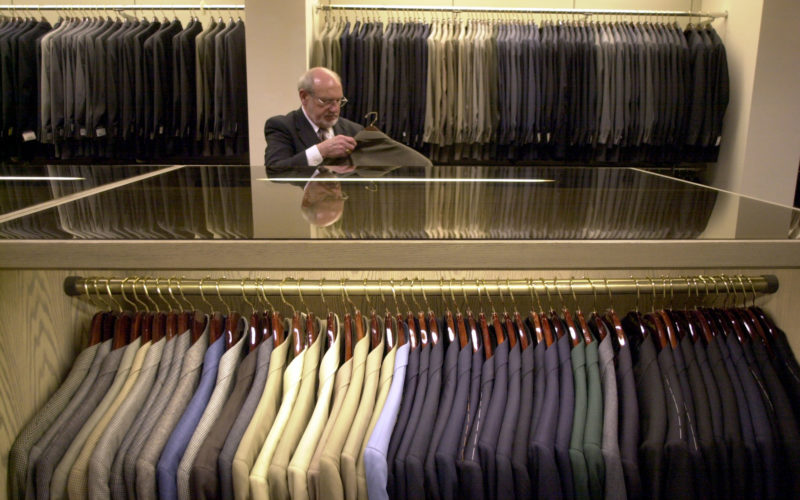Q. You often write about “good color in a man’s wardrobe,” but I’m not clear what that means. Especially given that for business the standards are white shirts and dark suits. I am really looking for specifics about color.
A. I do often state that color is free and that using it well costs no more than using it poorly. So I certainly appreciate your asking what constitutes using it well. There are two elements to the best use of color in clothing: good colors and good color coordination.
The first key element: colors that look good, that convey the desired image, and do not assault the eyes of others. Even a dark suit is still a color and should be the right one.
Color can say a variety of things about you, depending on the kind of image you want to convey. In an industry-wide meeting, a traditional dark blue or medium blue suit can say you are an accepted professional. A dressier very dark blue suit or a navy pinstripe can send a message that you are too elegant for a work session. An overly-bright blue suit is downright incorrect and can peg you as somewhere between the night manager of a suburban movie house and a messenger boy.
All this concluded from the color of a suit? I assure you it is. And it is done every day. That’s why color is so important. In the business world, color is a subtle power game, best played according to established, traditional rules. Knowing the color guidelines gives you freedom to move within them to establish your own style. First you have to know the rules; then you can break them. The easiest way to learn them is to work with the traditional business combination – suit, shirt, and tie. The same concepts also apply when you are dressed more casually.
The three accepted suit colors are blue, gray/black, and brown. In professional and business dressing, blues and grays should be in the medium to dark shades, and browns should be light to medium.
The next element is what takes a man from fitting in to standing out (in a good way). Color-coordinating, and not clashing or over-coordinating, is essential.
Consider this. Two men went into one of the better clothing stores in their city. They bought suits for $900, quality shirts, and fairly expensive ties. When one wore his chosen combination to an office meeting, he received compliments everywhere he turned. The other’s outfit was never even noticed.
The bottom line? The first man’s three pieces were extremely well color-coordinated. They had spark. He chose each as a component of a single plan, a formula that he followed. The other man spent the same amount of money, but the clothes he bought had no connection with each other. A second-rate appearance is what he accomplished.
BASIC COLOR RULES
- Begin with the suit color as a basepoint (blue, gray/black, or brown).
- Add a second or accent color for the shirt. (It should be lighter than the suit.)
- The necktie should be in the color family of the suit and pick up (repeat) the shirt color. Example: Blue suit, soft yellow shirt, navy-and-yellow tie.
- The shirt should be lighter than the suit; the tie should be darker than the shirt.
- Wear black shoes with blues and grays/black. Wear brown shoes with tan, khaki, browns, olive.
- Wear socks that match your shoes: black or brown (navy socks may be worn with blues). Business socks should be dark, preferably a solid color, and calf length. (No man can be well-dressed with skin showing above his socks.)
- A color should appear more than one place in an outfit; repeat colors.
- If shoes are brown, the belt should be some shade of brown.
- Pick up (repeat) the color of the shirt in the tie.
- Reds and yellows are so strong that they need not always be repeated.
- If worn at all, a silk pocket square should coordinate with (but not exactly match) the tie.
- Accent your hair or eye color if it is light. (With blue eyes, wear lots of blues.)
- Contrast your hair or eye color if it is dark. (With dark hair and olive coloring, choose clear colors; avoid dark browns, deep greens, olives, burgundy, mustard.)
OTHER RULES
- As an alternative color rule instead of choosing a basic color for the suit, plus a second color for the shirt, and repeating the two colors in the tie: Choose a color for the suit, a lighter shade of that same color for the shirt, and then choose a different, contrasting second color for the tie. Example: navy blue suit, light blue shirt, and a blue-and-red striped tie or a solid burgundy tie.
- Basically, your eye should see only two colors.
- Only one part of an outfit should stand out – no more than one item that is bright, shines, or is particularly noticeable. The best look is conservative.
- Avoid fad clothing for business or dressy evening wear. The most elegant look is classic.
- When buying neckties: Most useful tie – solid color – blue, brown, burgundy
- Most elegant (dressy) tie – pin-dot – light dot on dark background
- Most versatile tie – foulard – small, light pattern on dark ground
- Most traditional tie – repp (stripe)
- Best way to brighten a too-dull combination – paisley tie
It is difficult to be well-dressed without a full-length mirror and good lighting.
Please send your men’s dress and grooming questions to MALE CALL: Lois.Fenton@prodigy.net









